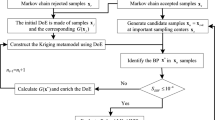Abstract
The accuracy of a classification-based surrogate model for reliability assessment can be improved by augmenting the training data (labeled data or data with known responses) with a large number of unlabeled data (data with unknown responses) in semi-supervised learning methods. In this research, an enhanced Probabilistic Neural Network (PNN) algorithm is proposed where the Gaussians at each labeled point are not assumed to be spherical. Each of the Gaussians has a ‘full’ covariance matrix instead of simply assuming the Gaussian with a ‘spherical’ covariance matrix. First, the Expectation-Maximization algorithm is applied on the labeled and unlabeled data while assuming that the number of ‘full’ Gaussians is equal to the number of labeled datapoints. The contribution of each of these ‘full’ Gaussians at a particular datapoint is found by using the Bayes Theorem. The Bayes decision criterion is then used in the final output layer of the PNN to classify test patterns into either the safe or the failure class. The primary benefit of the proposed method comes from utilizing unlabeled data for better estimation of ‘full’ covariance matrices of constituting Gaussian clusters of underlying data, which are then used to estimate the Probability Density Functions of classes for classification. This procedure does not require additional computational costs to improve the accuracy of the classification results since the cost of unlabeled data is negligible in general. Two examples including an analytic problem and a truss problem are presented in order to validate the proposed reliability estimation process. The results reflect considerable improvements of the classifier performance for estimating reliability while maintaining sufficient accuracy.
Similar content being viewed by others
References
Basudhar A., Missoum S., Sanchez A. H. (2008) Limit state function identification using support vector machines for discontinous responses and disjoint failure domains. Probabilistic Engineering Mechanics 23: 1–11
Bishop C. M. (1996) Neural networks for pattern recognition. Oxford University Press, USA
Bouchard, G., & Triggs, B. (2004). The trade-off between generative and discriminative classifiers. In IASC 16th international symposium on computational statistics, Prague, Czech Republic, pp. 721–728.
Cacoullos T. (1966) Estimation of multivariate density. Annals of Mathematical Statistics 18(2): 179–189
Chapelle O., Schölkopf B., Zien A. (2006) Semi-supervised learning. MIT Press, Cambridge, MA
Choi S., Grandhi R. V., Canfield R. A. (2006) Reliability-based design optimization. Springer, London
Cohen I., Gozman F. G., Sebe N., Cirelo M. C., Huang T. S. (2004) Semisupervised learning of classifiers: Theory, algorithms, and their application to human-computer interaction. IEEE Transactions on Pattern Analysis and Machine Intelligence 26(12): 1553–1567
Dempster A. P., Laird N. M., Rubin D. B. (1977) Maximum likelihood from incomplete data via the EM algorithm. Journal of Royal Statistical Society Series B 39: 1–38
Fukunaga K. (1990) Introduction to statistical pattern recognition. Academic Press, San Diego, CA
Gan, G., Ma, C., & Wu, J. (2007). In Data clustering: Theory, algorithms and applications. Philadelphia, ASA, Alexandria, VA: ASA-SIAM Series on Statistics and Applied Probability, SIAM.
Hastie, T., Tibshirani, R., & Friedman, J. (2009). The elements of statistical learning: Data mining, inference and prediction, 2nd edn. Springer Series in Statistics. Berlin: Springer.
Lanquillon, C. (2000). Partially supervised text classification: Combining labeled and unlabeled documents using an EM-like scheme. Lecture Notes in Computer Science, Vol. 1810/2000, pp. 229–237.
McLachlan G. J., Basford K. E. (1988) Mixture models: Inference and applications to clustering. In: Owen D. B. (eds) Statistics: Textbooks and monographs. Marcel Dekker Inc., New York
Nigam K., McCallum A. K., Thrun S., Mitchell T. (1999) Text classification from labeled and unlabeled documents using EM. Machine Learning 39(2–3): 103–134
Parzen E. (1962) On estimation of a probability density function and mode. Annals of Mathematical Statistics 33: 1065–1076
Patel, J., & Choi, S. (2011). Classification-based reliability assessment with semi-supervised learning. In 52nd AIAA/ASME/ASCE/AHS/ ASC structures, structural dynamics, and material conference and 7th AIAA multidisciplinary design optimization specialist conference. Denver, CO.
Patel J., Choi S.-K. (2012) Classification approach for reliability-based topology optimization using probabilistic neural networks. Structural and Multidisciplinary Optimization 45(4): 529–543
Specht D. F. (1990) Probabilistic neural networks. Neural Networks 3: 109–118
Zhang G. P. (2000) Neural networks for classification: A survey. IEEE Transactions on Systems, Man, and Cybernetics- Part C: Applications and Reviews 30(4): 451–462
Zhu X., Goldberg A. B. (2009) Introduction to semi-supervised learning. Morgan and Claypool, CA
Author information
Authors and Affiliations
Corresponding author
Rights and permissions
About this article
Cite this article
Patel, J., Choi, SK. An enhanced classification approach for reliability estimation of structural systems. J Intell Manuf 25, 505–519 (2014). https://doi.org/10.1007/s10845-012-0702-1
Received:
Accepted:
Published:
Issue Date:
DOI: https://doi.org/10.1007/s10845-012-0702-1




